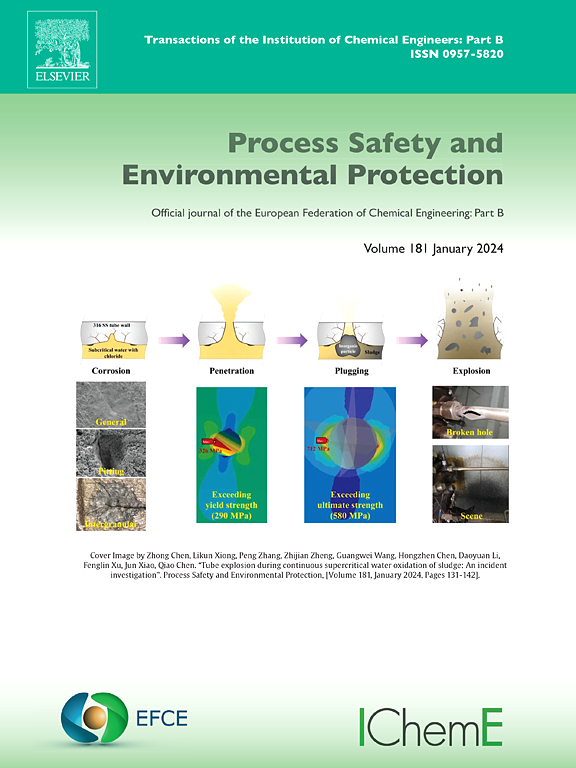衬底结构对涂覆SCO-SCR催化剂的DPF被动烟尘氧化和NOx还原效果的影响评价
IF 7.8
2区 环境科学与生态学
Q1 ENGINEERING, CHEMICAL
引用次数: 0
摘要
在柴油微粒过滤器(DPF)上应用选择性催化还原/氧化(SCR/SCO)催化剂是满足严格排放法规的关键策略。与传统的Cu-SSZ-13涂层DPF相比,新型SCO-SCR集成DPF (n-SDPF)具有增强同时燃烧烟尘和减少NOx的双重功能。本研究建立了流体力学、传质、化学反应和传热等因素耦合的多物理场模型,以评估衬底结构对n-SDPF烟尘氧化和NOx还原的影响。关键发现表明,SCR催化途径比NH3氧化过程表现出优先活化。增强的过滤器壁厚和延长的过滤器壁长成比例地增加了活性位点密度,而优化的入口与出口通道宽度比促进了气相反应物的电荷。当过滤壁厚由0.25mm增加到0.4mm时,NOx最大转化效率由74.76%提高到86.39%,烟尘最大氧化效率由15.03%提高到15.83%。当过滤器壁长从140mm增加到200mm时,NOx转化效率从78.45%提高到88.41%,烟尘氧化效率从14.62%提高到18.28%。当进出口通道宽度比由1增加到1.6时,NOx转化效率由91.01%下降到77.85%,烟尘氧化效率由20.04%下降到14.41%。延长滤壁长度显示出优越的技术优势,在提高氮氧化物转化效率和提高烟灰氧化率的同时,降低了烟灰饼层和滤壁的压降。本研究揭示了催化反应与底物结构之间的耦合关系。研究结果将为n-SDPF的设计和实际应用提供理论支持。本文章由计算机程序翻译,如有差异,请以英文原文为准。
Evaluation of the effect of substrate structure on the passive soot oxidation and NOx reduction of DPF coated with SCO-SCR catalyst
The application of selective catalytic reduction/oxidation (SCR/SCO) catalysts onto diesel particulate filters (DPF) constitutes a critical strategy for meeting stringent emission regulations. Compared to conventional Cu-SSZ-13 coated on DPF, the novel SCO-SCR integrated DPF (n-SDPF) demonstrates dual functionality in enhancing simultaneous soot combustion and NOx abatement. In this study, a multiphysics model couples factors such as fluid dynamics, mass transfer, chemical reaction and heat transfer was established to assess the impact of substrate structure on soot oxidation and NOx reduction of n-SDPF. Key findings reveal that, SCR catalytic pathways exhibit preferential activation over NH3 oxidation processes. Enhanced filter wall thickness and extended filter wall length proportionally increase active site density, whereas optimized inlet-to-outlet channel width ratios promote gas-phase reactant charge. When the filter wall thickness increased from 0.25 mm to 0.4 mm, the maximum NOx conversion efficiency increased from 74.76 % to 86.39 %, and the maximum soot oxidation efficiency increased from 15.03 % to 15.83 %. When the filter wall length increased from 140 mm to 200 mm, the NOx conversion efficiency increased from 78.45 % to 88.41 %, and the soot oxidation efficiency increased from 14.62 % to 18.28 %. When the inlet-to-outlet channel width ratio increased from 1 to 1.6, the NOx conversion efficiency decreased from 91.01 % to 77.85 %, and the soot oxidation efficiency decreased from 20.04 % to 14.41 %. Filter wall length extension demonstrates superior technical advantages, achieving improvement in NOx conversion efficiency and enhancement in soot oxidation rates while concurrently reducing pressure drop across both soot cake layers and filter walls. In this study, the coupling relationship between catalytic reaction and substrate structure is revealed. The findings will provide theoretical support for n-SDPF design and practical applications.
求助全文
通过发布文献求助,成功后即可免费获取论文全文。
去求助
来源期刊

Process Safety and Environmental Protection
环境科学-工程:化工
CiteScore
11.40
自引率
15.40%
发文量
929
审稿时长
8.0 months
期刊介绍:
The Process Safety and Environmental Protection (PSEP) journal is a leading international publication that focuses on the publication of high-quality, original research papers in the field of engineering, specifically those related to the safety of industrial processes and environmental protection. The journal encourages submissions that present new developments in safety and environmental aspects, particularly those that show how research findings can be applied in process engineering design and practice.
PSEP is particularly interested in research that brings fresh perspectives to established engineering principles, identifies unsolved problems, or suggests directions for future research. The journal also values contributions that push the boundaries of traditional engineering and welcomes multidisciplinary papers.
PSEP's articles are abstracted and indexed by a range of databases and services, which helps to ensure that the journal's research is accessible and recognized in the academic and professional communities. These databases include ANTE, Chemical Abstracts, Chemical Hazards in Industry, Current Contents, Elsevier Engineering Information database, Pascal Francis, Web of Science, Scopus, Engineering Information Database EnCompass LIT (Elsevier), and INSPEC. This wide coverage facilitates the dissemination of the journal's content to a global audience interested in process safety and environmental engineering.
 求助内容:
求助内容: 应助结果提醒方式:
应助结果提醒方式:


